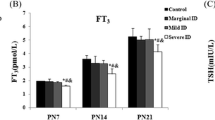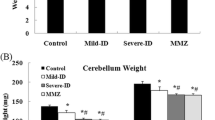Abstract
Adequate thyroid hormone is critical for cerebellar development. Developmental hypothyroidism induced by iodine deficiency during gestation and postnatal period results in permanent impairments of cerebellar development with an unclear mechanism. In the present study, we implicate cerebellar caveolin-1 and synaptotagmin-1, the two important molecules involved in neuronal development, in developmental iodine deficiency, and in developmental hypothyroidism. Two developmental rat models were created by administrating dam rats with either iodine-deficient diet or propylthiouracil (PTU, 5 or 15 ppm)-added drinking water from gestational day 6 till postnatal day (PN) 28. Nissl staining and the levels of caveolin-1 and synaptotagmin-1 in cerebella were assessed on PN28 and PN42. The results show that the numbers of Purkinje cells were reduced in the iodine-deficient and PTU-treated rats. The upregulation of caveolin-1 and the downregulation of synaptotagmin-1 were observed in both iodine-deficient and PTU-treated rats. These findings may implicate decreases in the number of Purkinje cells and the alterations in the levels of caveolin-1 and synaptotagmin-1 in the impairments of cerebellar development induced by developmental iodine deficiency and hypothyroidism.



Similar content being viewed by others
References
Sui L, Gilbert ME (2003) Pre- and postnatal propylthiouracil-induced hypothyroidism impairs synaptic transmission and plasticity in area CA1 of the neonatal rat hippocampus. Endocrinology 144:4195–4203
Bernal J (2002) Action of thyroid hormone in brain. J Endocrinol Invest 25:268–288
Kibirige MS, Hutchison S, Owen CJ, Delves HT (2004) Prevalence of maternal dietary iodine insufficiency in the north east of England: implications for the fetus. Arch Dis Child Fetal Neonatal Ed 89:F436–F439
Berbel P, Obregon MJ, Bernal J, Escobar del Rey F, Morreale de Escobar G (2007) Iodine supplementation during pregnancy: a public health challenge. Trends Endocrinol Metab 18:338–343
Zimmermann MB (2008) Iodine requirements and the risks and benefits of correcting iodine deficiency in populations. J Trace Elem Med Biol 22:81–92
Alissa EM, AlShali K, Ferns GA (2009) Iodine deficiency among hypothyroid patients living in Jeddah. Biol Trace Elem Res 130:193–203
Melse-Boonstra A, Jaiswal N (2010) Iodine deficiency in pregnancy, infancy and childhood and its consequences for brain development. Best Pract Res Clin Endocrinol Metab 24:29–38
Farwell AP, Dubord-Tomasetti SA (1999) Thyroid hormone regulates the expression of laminin in the developing rat cerebellum. Endocrinology 140:4221–4227
Koibuchi N, Jingu H, Iwasaki T, Chin WW (2003) Current perspectives on the role of thyroid hormone in growth and development of cerebellum. Cerebellum 2:279–289
Sinha RA, Pathak A, Kumar A, Tiwari M, Shrivastava A, Godbole MM (2009) Enhanced neuronal loss under perinatal hypothyroidism involves impaired neurotrophic signaling and increased proteolysis of p75(NTR). Mol Cell Neurosci 40:354–364
Alvarez-Dolado M, Figueroa A, Kozlov S, Sonderegger P, Furley AJ, Munoz A (2001) Thyroid hormone regulates TAG-1 expression in the developing rat brain. Eur J Neurosci 14:1209–1218
Koibuchi N (2008) The role of thyroid hormone on cerebellar development. Cerebellum 7:530–533
Gaudreault SB, Blain JF, Gratton JP, Poirier J (2005) A role for caveolin-1 in post-injury reactive neuronal plasticity. J Neurochem 92:831–839
Trushina E, Du Charme J, Parisi J, McMurray CT (2006) Neurological abnormalities in caveolin-1 knock out mice. Behav Brain Res 172:24–32
Shaul PW, Anderson RG (1998) Role of plasmalemmal caveolae in signal transduction. Am J Physiol 275:L843–L851
Rothberg KG, Heuser JE, Donzell WC, Ying YS, Glenney JR, Anderson RG (1992) Caveolin, a protein component of caveolae membrane coats. Cell 68:673–682
Wary KK, Mariotti A, Zurzolo C, Giancotti FG (1998) A requirement for caveolin-1 and associated kinase Fyn in integrin signaling and anchorage-dependent cell growth. Cell 94:625–634
Smart EJ, Ying Y, Donzell WC, Anderson RG (1996) A role for caveolin in transport of cholesterol from endoplasmic reticulum to plasma membrane. J Biol Chem 271:29427–29435
Grande-Garcia A, del Pozo MA (2008) Caveolin-1 in cell polarization and directional migration. Eur J Cell Biol 87:641–647
Bu J, Bruckner SR, Sengoku T, Geddes JW, Estus S (2003) Glutamate regulates caveolin expression in rat hippocampal neurons. J Neurosci Res 72:185–190
Francesconi A, Kumari R, Zukin RS (2009) Regulation of group I metabotropic glutamate receptor trafficking and signaling by the caveolar/lipid raft pathway. J Neurosci 29:3590–3602
Matthew WD, Tsavaler L, Reichardt LF (1981) Identification of a synaptic vesicle-specific membrane protein with a wide distribution in neuronal and neurosecretory tissue. J Cell Biol 91:257–269
Fukuda M (2006) Distinct developmental expression of synaptotagmin I and IX in the mouse brain. Neuroreport 17:179–182
Loewen CA, Mackler JM, Reist NE (2001) Drosophila synaptotagmin I null mutants survive to early adulthood. Genesis 31:30–36
Mikoshiba K, Fukuda M, Ibata K, Kabayama H, Mizutani A (1999) Role of synaptotagmin, a Ca2+ and inositol polyphosphate binding protein, in neurotransmitter release and neurite outgrowth. Chem Phys Lipids 98:59–67
Xiao Z, Gong Y, Wang XF, Xiao F, Xi ZQ, Lu Y, Sun HB (2009) Altered expression of synaptotagmin I in temporal lobe tissue of patients with refractory epilepsy. J Mol Neurosci 38:193–200
National Research Council, Institute of Laboratory Animal Resources, Commission on Life Sciences (1996) Guide for the care and use of laboratory animals, 7th edn. National Academy Press, Washington, D.C
Dong J, Yin H, Liu W, Wang P, Jiang Y, Chen J (2005) Congenital iodine deficiency and hypothyroidism impair LTP and decrease C-fos and C-jun expression in rat hippocampus. Neurotoxicology 26:417–426
Matchett GA, Calinisan JB, Matchett GC, Martin RD, Zhang JH (2007) The effect of granulocyte-colony stimulating factor in global cerebral ischemia in rats. Brain Res 1136:200–207
He J, Yamada K, Zou LB, Nabeshima T (2001) Spatial memory deficit and neurodegeneration induced by the direct injection of okadaic acid into the hippocampus in rats. J Neural Transm 108:1435–1443
Gong J, Dong J, Wang Y, Xu H, Wei W, Zhong J, Liu W, Xi Q, Chen J (2010) Developmental iodine deficiency and hypothyroidism impair neural development, up-regulate caveolin-1, and down-regulate synaptophysin in rat hippocampus. J Neuroendocrinol 22:129–139
Gong J, Liu W, Dong J, Wang Y, Xu H, Wei W, Zhong J, Xi Q, Chen J (2010) Developmental iodine deficiency and hypothyroidism impair neural development in rat hippocampus: involvement of doublecortin and NCAM-180. BMC Neurosci 11:50
Tang Z, Liu W, Yin H, Wang P, Dong J, Wang Y, Chen J (2007) Investigation of intelligence quotient and psychomotor development in schoolchildren in areas with different degrees of iodine deficiency. Asia Pac J Clin Nutr 16:731–737
Benton D (2008) Micronutrient status, cognition and behavioral problems in childhood. Eur J Nutr 3:38–50
Zhang L, Sun YN, Li YM, Lin LX, Ye Y, Yan YQ, Chen ZP (2011) Effect of different iodine nutrition on cerebellum Pcp-2 in rat offspring during lactation. Biol Trace Elem Res. doi:10.1007/s12011-011-8991-3
Koibuchi N (2009) Animal models to study thyroid hormone action in cerebellum. Cerebellum 8:89–97
Dong H, Yauk CL, Rowan-Carroll A, You SH, Zoeller RT, Lambert I, Wade MG (2009) Identification of thyroid hormone receptor binding sites and target genes using ChIP-on-chip in developing mouse cerebellum. PLoS ONE 4:e4610
Vallortigara J, Alfos S, Micheau J, Higueret P, Enderlin V (2008) T3 administration in adult hypothyroid mice modulates expression of proteins involved in striatal synaptic plasticity and improves motor behavior. Neurobiol Dis 31:378–385
Moriyama K, Tagami T, Usui T, Naruse M, Nambu T, Hataya Y, Kanamoto N, Li YS, Yasoda A, Arai H, Nakao K (2007) Antithyroid drugs inhibit thyroid hormone receptor-mediated transcription. J Clin Endocrinol Metab 92:1066–1072
Shrader RE, Keen CL, Hurley LS, Zeman FJ (1982) Hematologic and trace element alterations following chronic maternal ingestion of propylthiourea. Exp Hematol 10:44–55
Gonzalez-Reimers E, Santolaria-Fernandez F, Perez-Labajos J, Rodriguez-Moreno F, Martinez-Riera A, Hernandez-Torres O, Valladares-Parrilla F, Molina-Perez M (1996) Relative and combined effects of propylthiouracil, ethanol and protein deficiency on liver histology and hepatic iron, zinc, manganese and copper contents. Alcohol 31:535–545
Kazi TG, Kandhro GA, Afridi HI, Kazi N, Baig JA, Arain MB, Shah AQ, Syed N, Kumar S, Kolachi NF, Khan S (2010) Interaction of copper with iron, iodine, and thyroid hormone status in goitrous patients. Biol Trace Elem Res 134:265–279
Koibuchi N, Chin WW (1999) Mechanisms underlying neurological abnormalities resulting from developmental hypothyroidism. Curr Opin Endocrinol Diabetes Obes 6:26–32
Howdeshell KL (2002) A model of the development of the brain as a construct of the thyroid system. Environ Health Perspect 110:337–348
Virgintino D, Robertson D, Errede M, Benagiano V, Girolamo F, Maiorano E, Roncali L, Bertossi M (2002) Expression of caveolin-1 in human brain microvessels. Neuroscience 115:145–152
Poirier J (1994) Apolipoprotein E in animal models of CNS injury and in Alzheimer’s disease. Trends Neurosci 17:525–530
Royland JE, Parker JS, Gilbert ME (2008) A genomic analysis of subclinical hypothyroidism in hippocampus and neocortex of the developing rat brain. J Neuroendocrinol 20:1319–1338
Head BP, Peart JN, Panneerselvam M, Yokoyama T, Pearn ML, Niesman IR, Bonds JA, Schilling JM, Miyanohara A, Headrick J, Ali SS, Roth DM, Patel PM, Patel HH (2010) Loss of caveolin-1 accelerates neurodegeneration and aging. PLoS ONE 5:e15697
Littleton JT, Serano TL, Rubin GM, Ganetzky B, Chapman ER (1999) Synaptic function modulated by changes in the ratio of synaptotagmin I and IV. Nature 400:757–760
Zhu DF, Liu CL, Xu YX, Zhan Y, Hu HL, Jia XM, Chen GH (2011) Effect of thyroxine on synaptotagmin 1 and SNAP-25 expression in dorsal hippocampus of adult-onset hypothyroid rats. J Endocrinol Invest 34(4):280–286. doi:10.3275/7106
Xi D, Chin H, Gainer H (1999) Analysis of synaptotagmin I–IV messenger RNA expression and developmental regulation in the rat hypothalamus and pituitary. Neuroscience 88:425–435
Lakshmy R, Srinivasarao P (1997) Effect of thiocyanate on microtubule assembly in rat brain during postnatal development. Int J Dev Neurosci 15:87–94
Acknowledgments
This work was supported by the National Natural Science Foundation of China [grant number 30800896] and also supported by Natural Science Foundation of Liaoning Province, China for Ph.D. holders [grant number 20081053]. The excellent theoretical and technical help of Professor Hong Lai and Professor Zhanyou Wang from the College of Basic Medical Sciences at China Medical University is gratefully acknowledged.
Author information
Authors and Affiliations
Corresponding author
Rights and permissions
About this article
Cite this article
Wang, Y., Zhong, J., Wei, W. et al. Developmental Iodine Deficiency and Hypothyroidism Impair Neural Development, Upregulate Caveolin-1, and Downregulate Synaptotagmin-1 in the Rat Cerebellum. Biol Trace Elem Res 144, 1039–1049 (2011). https://doi.org/10.1007/s12011-011-9089-7
Received:
Accepted:
Published:
Issue Date:
DOI: https://doi.org/10.1007/s12011-011-9089-7




